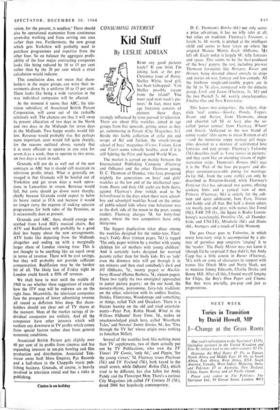Kid Stuff
CONSUMING INTEREST
By LESLIE ADRIAN
READ any good pictures lately? If you think I'm joking, look at the pre- Christmas issue of Bunty. Shelley White, head girl, has been kidnapped: 'Can Shelley possibly escape from the island? You must read next week's pic- tures.' In fact, most teen- age literature consists of
pictures these days, strongly influenced by (you guessed it) television. There are about fifty weeklies, aimed at age groups from five upwards, getting sexier as they go, culminating in Parade (City Magazines, Is.). Beside this feeble collection of girlie pix and scraps of fict and faction, the smash-'em-up school of boys' magazines (Victor, Valiant, Lion and Tiger) seems robustly healthy, even if it is still fighting the First and Second World Wars.
The market is carved up mainly between the International Publishing Company (Fleetway and Odhams) and the other Thomson group, D. C. Thomson of Dundee, who have prospered mightily for generations on boys' and girls' weeklies at the low end of the intellectual spec- trum. Bunty and Judy (5d. each) are both theirs, against Fleetway's June (which used to be Schoolfriend in the days when there were school- boy and schoolgirl weeklies based on the antics of public-school kids whose true behaviour was as the dark side of the moon to the poor, young reader). Fleetway charges 7d. for forty-four pages, where the two competitors have only thirty-two.
The biggest duplication takes place among the weeklies designed for the under-tens. Fleet- way's Teddy Bear (sixteen pages, 7d.) is tagged The only paper written by a mother with young children for all mothers with young children.' And it certainly looks designed for worried parents rather than for lively kids. It's so 'safe' even the dimmest mite will get through it in ten minutes and then steal somebody's Jack and Jill (Odhams, 7d., twenty pages) or Huckle- berry Hound (Hanna Barbera, 7d., sixteen pages). These two typify the two unoriginal approaches to junior picture papers: on the one hand, the nursery-rhyme, pantomime, fairy-tale tradition; on the other, television with its endless Sooties, Daleks, Flintstones, Woodentops and something, or things, called Tich and Quackers. There is a blatant leaning on the old and tried entertain- ments—Peter Pan, Robin Hood, Wind in the Willows (Odhams' Story Time, 7d., makes an unacknowledged pinch here, called 'Riverbank Tales,' and Newnes' Sunny Stories, 9d., has 'Tina through the TV Set' whose origin owes nothing to Jonathan Miller).
Several of the weeklies look like nothing more than TV supplements, two of them actually put out by TV Publications, who own the TV Times: TV Comic, 'only 6d.,' and Pippin, 'for the young viewer,' 7d. Fleetway issues Playhour (7d.) and TV Toyland (741.), both keyed to the small screen, while Odhams' Robin (7d.), which used to be different, has also fallen for Andy Pandy and the Flowerpot Men. There's a curious City Magazines job called TV Century 21 (7d.), dated 2066 but hopelessly contemporary.
D. C. Thomson's Bimbo (6d.) not only scores a price advantage, it has no telly tales at all, but relies on tradition. Fleetway's Treasure, a lavish Is. 3d. worth, is pitched at the intelligent child and seems to have taken up where tits original Marcus Morris Eagle (Odhams, 7d) left off. Eagle today is largely SF, telly fantasies and space. This seems to be the best-produced of the boys' papers, the rest, including pre-war Thomson favourites like Hotspur, Rover and Hornet, being devoted almost entirely to strips and stories on war, fantasy and low comedy. All the lowbrow rough-and-tumble papers are in the 5d. to 7d. class, compared with the didactic group, Look and Learn (Fleetway, Is. 3d.) and the two Purnell 2s. 6d. weekly encyclopaedias, Finding Out and New Knowledge.
This leaves two categories: the vulgar, slap- stick 'real' comics—Spalky, Dandy, Topper, Beano and Beezer, from Thomsons, cheap and cheerful (all 5d. or less), plus the so- called 'power comics' from Fleetway, Wham! and Smash, 'dedicated to the new brand of comic reader' (this seems to mean Batman et al.) —and the numerous soppy teenage girl maga- zines devoted to a mixture of sentimental love fantasies and pop groups. Fleetway's Valentine (7d.) describes itself as 'Love stories in pictures,' and they seem like an unending stream of night- starvation strips. Thomson's Romeo (6d.) says it is the 'Pick of the love pic-papers' and dis- plays seventeen-year-olds pining for marriage. Jackie (6d., from the same stable) can only be described as flirtation-fixated, while Fleetway's Petticoat (Is.) has advanced two points, offering cookery hints and a cynical view of men. Princess (Fleetway, 9d.) is strictly for the sub- teen and quiet adolescent, Jane Eyre, Tristan and Isolde and all that. But half a dozen others are mostly pop and gear, with names like Trend (9d.), FAB 208 (Is., the figure is Radio Luxem- bourg's wavelength), Premiere (7d., all Thunder- birds and UNCLE), Mirabelle (8d.) and Diane (6d., Avengers and a touch of Little Women).
The goo Oscar goes to Valentine, in which every love-story strip is accompanied by a pic- ture of gormless pop songsters 'singing' it to the 'reader.' The Daily Mirror may not know it (though I'd be surprised if they didn't), but Andy Capp has a little cousin in Buster (Fleetway, 7d.), with an army of characters in support with names like Dinah Mite and Nutty Slack, not to mention Jimmy Edwards, Charlie Drake and Benny Hill. After all this, I found myself longing for Chips, the Boy's Own Paper and Chums. But they were pre-telly, pre-pop and just as preposterous.






































 Previous page
Previous page